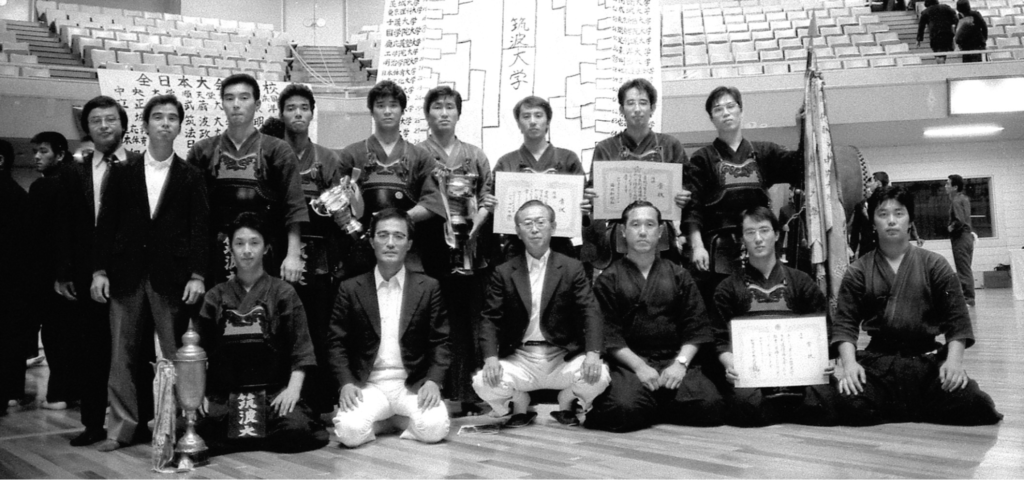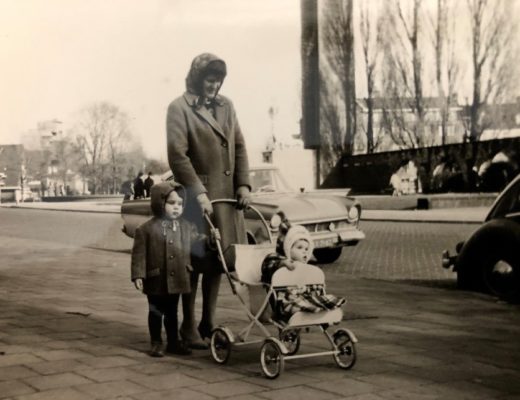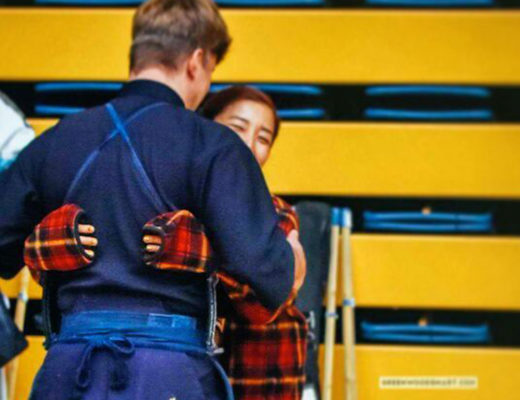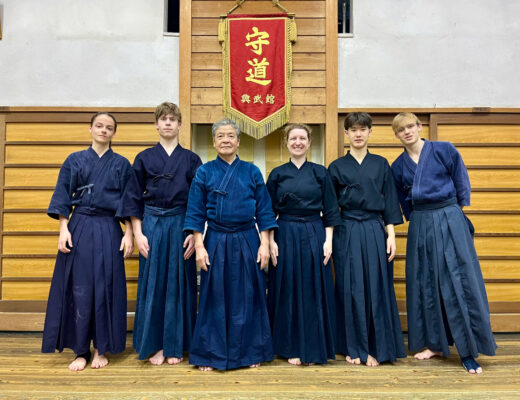2008.1 KENDOJIDAI
I was asked to write my personal history in Kendo. As a person who is still in the process of training, I have not had the time to look back over my life, but have only been moving forward. In addition, I have no significant Kendo-related accomplishments or achievements, so I have been hesitant to publish this as a personal history. However, my life as a Kendo practitioner has been guided and nurtured by the history of my predecessors, who struggled to build the Kendo world of today in the turbulent times before and after World War II. As it is now fifty years since I set out to become a professional Kendo instructor, I thought it would be helpful to look back on my own humble life in Kendo to help further my training, and also to provide some kind of reference for younger students who are training in today’s blessed environment.
Sato Nariaki, 8th Dan Hanshi
Born in Tochigi Prefecture in 1938, 82 years old. After graduating from Utsunomiya High School, he went on to Tokyo University of Education, where he majored in physical education, and then to the Graduate School of Education. After working as an assistant professor at Komazawa University, he became an instructor at his alma mater, Tokyo University of Education, before retiring as a professor at Tsukuba University in 2002. He has participated in the All Japan Championships, the World Championships, the National Athletic Meet, the National Teachers’ Meet,and the All Japan East-West Tournament. He is currently a professor emeritus at Tsukuba University. Acting President of the All Japan Student Kendo Federation.
From Tokyo University of Education to Tsukuba University
Walking the path of a Kendo instructor
In April 1966, I began my career as a Kendo instructor, as a lecturer at the Faculty of Literature, Komazawa University and as a teaching assistant at the Faculty of Physical Education at the Tokyo University of Education. I spent my days teaching classes in Komazawa, Otsuka, and Hatagaya, and doing regular Keiko with the Kendo Clubs.
In October 1970, I became an assistant professor at the Faculty of Physical Education, Tokyo University of Education, and began a life of education and research under Professor Nakano Yasoji. In the first half of the 1970s, the wave of university disputes that occurred all over Japan spread to both Komazawa University and Tokyo University of Education. At the Tokyo University of Education, the struggle against the relocation of the university to Tsukuba occured in conjunction with the occupation of the dean’s office, the blockade of the university and the introduction of riot police into the campus, resulting in a tumultuous situation. As a young instructor, I was mobilized to deal with students, protect the dean, prevent student demonstrators from entering the university and guard against the obstruction of entrance examinations. Even though it was the trend of the time, it was an unusual experience.
In spite of all this, the Kendo Club continued to do Keiko. With the establishment of the new martial arts curriculum, the number of students who had proven themselves in high school and were capable of joining the club increased and the training became more lively than before. During this period, we did not win any team championships, but we did win second and third places. When we look at the achievements of the students of that time in the world of education and Kendo after graduation, we can confirm that it had value for their personal development.
In October 1973, the University of Tsukuba was opened under a new vision and in April 1974, the first students were admitted to the School of Physical Education and the School of Arts. Nakiri Fuminori Sensei (currently a professor at Tokyo University of Agriculture and Technology) was appointed as an associate researcher for MEXT. The construction work in Sakura Village (now Tsukuba City) was greatly delayed and students had to take classes at the Olympic Youth Center in Yoyogi or Hatagaya. Classes began in Tsukuba late in May, but the university itself had only a physical education building, a gymnasium and an athletic field. The Kendo hall was not completed until June 1978, when the first students graduated, and until then, Kendo classes and Keiko were held in a rented dance hall.
Every Saturday and Sunday, students carried their equipment to Hatagaya to participate in the Kendo Club of the Tokyo University of Education. They stayed at the student dormitories, lodgings for senior students and Dojos with rental futons. This is a painful and nostalgic fact that the students of those days will never forget. At the construction site, the position of the road sometimes changed from morning to evening depending on the day. They had to bring their own water bottles, and in those rainy years to be able to walk through the mud, they had to wear what they referred to as “Tsukuba Shoes”, which were rain boots or mountain climbing shoes, to “go to work” in Tokyo. Isolated from the world, those students usually wore training shirts, training pants and those boots.
Until the closing of the Physical Education Department of the Tokyo University of Education in 1977, I was concurrently working at Tsukuba University for morning classes at Tsukuba and afternoon classes at Hatagaya. I may have been able to do that because of my youth. In 1975, Imai Saburo Sensei from Niigata University was transferred to the University of Tsukuba, along with the late Nakabayashi Shinji Sensei, who was in charge of Budo theory from Hatagaya, and the late Tsuboi Saburo Sensei who arrived when the Tokyo University of Education closed, expanding the teaching team for Kendo education.
In 1977, the name registered with the school federation was changed from Tokyo University of Education to the University of Tsukuba. Horibe Akemi won the Women’s Student Championship when she was a second year student of the Tokyo University of Education, and when she won the championship for the second time, it was as a student of the University of Tsukuba.
Although we moved to Tsukuba University and attracted talents through the athletic scholarship system, we were not able to take any other titles in student competitions. In any case, it is clear that the team was making a desperate effort in very inconvenient circumstances far from Tokyo. At the time there were anonymous phone calls and conversations that could be considered criticism that went along the lines of “The coaching team was bad” and “the coach was smiling even after being defeated”.
In 1980, we were able to win our first Kanto Tournament and the National Tournament with the 4th generation of students Matsubara Kenji (Kotohira High School, Kagawa Prefecture) Takahashi Ryo (Akita Minami High School, Akita Prefecture) Hirata Yoshihiro (Saidaiji High School, Okayama Prefecture) and Hattori Kiaki (Yatsushiro Higashi High School, Kumamoto Prefecture) as our main competitors. Later, during my tenure at Tsukuba University, the team of the 6th generation won the National Tournament with Yamanaka Yosuke (PL Gakuen High School, Osaka Prefecture) and Kanzaki Hiroshi (Nobeoka High School, Miyazaki Prefecture). The 9th generation won with Saga Yutaka (PL Gakuen High School, Osaka Prefecture) and Tomita Takayuki (Karatsu Higashi High School, Saga Prefecture), and the 11th generation with Saga Satoshi (Tokai University Daishi High School, Hokkaido).
The finals against Osaka University of Health and Sport Sciences led by coach Sakudo Masao, with whom I had worked side by side as a teaching assistant when I was in the Tokyo University of Education, were closely contested with Tsukuba taking the first finals and Osaka University of Health and Sport Sciences winning the second time. During the 10th generation with Imazato Manabu (Tokai University Sagami High School, Kanagawa Prefecture), I dared to leave out the most senior students from the competitors for the Shiai. There was a roar of condemnation, but taking the title settled the case. However, if the result had not been good, who knows what would have happened. I blamed myself inwardly for that.
I have a bitter memory of coming short of winning three consecutive titles with Nabeyama Takahiro of the 15th generation (PL Gakuen High School, Osaka Prefecture) and Kono Yuichi (Takachiho High School, Miyazaki Prefecture) and Yuji Arita (PL Gakuen High School, Osaka Prefecture) of the 16th generation. In the individual competitions, Yamanaka Yosuke, Saga Yutaka, Matsuo Yoshiro (Sasebo Minami High School, Nagasaki Prefecture), Arita Yuji, and Kikukawa Shogo (Toin Gakuen High School, Kanagawa Prefecture) took titles.
The women’s teams have had an excellent record in the individual competitions. The champions were Horibe Akemi (twice), Harada Atsuko (currently Hasebe), Uchida Yayoi (currently Miyazaki), Tanaka Miwa (currently Shimosaka), Sakaki Tomoko (currently Horikawa), Fujita Hiromi, Murayama Chinatsu, and Sugimoto Saeko became title holders. They are followed by their Kohai.
In the team competition, during my tenure, the men’s team won the All-Japan Championships six times, placed second twice and third five times, and won the Kanto tournament three times, placed second five times and third six times. In the Women’s All-Japan Tournament, she has won three times, placed second four times, and third four times, and in the Kanto Tournament, she has won ten times, placed second five times, and third four times.
The tournament held at the Nippon Budokan in October 2001 was my last tournament as the head of the department, and it was a very moving tournament where I was presented with a memorable victory by the 25th Mr. Satoshi Furuya (the late Tsuchiura Nichidai Iwase High School, Ibaraki Prefecture) and his team. Mr. Furuya suddenly passed away the following year. Even after my retirement, my juniors have continued to fight hard.

Establishment of the International Kendo Federation
Thoughts on the Internationalization of Kendo
The rest of this article is only available for Kendo Jidai International subscribers!





